#adaptive software development
Explore tagged Tumblr posts
Text
How to Future-Proof Agile with Adaptive Software Development
Agile transformed software development by increasing teams flexible, more sensitive and efficient. Traditional agile methods, however, often try to maintain the pace with rapidly developing technologies, customer expectations and market disorders. Response? Adaptive software development (ASD)-A dynamic approach that increases agile methodologies by supporting continuous learning, iterative improvement and real-time adaptability.
At, CodeRower We get rid of software development, automation and digital transformation that integrate Adaptive principles of software development in the future of agile work-flows. This guide examines how to successfully accept ASD and ensure that your agile teams remain resistant to the ever-changing digital landscape.
What is Adaptive Software Development?
Adaptive software development (ASD) is a highly flexible and iterative approach that builds on agile methodologies. Unlike the traditional agil, which is governed by structured sprints, ASD focuses on continuous adaptation, allowing software to develop software in response to changing market needs.
Basic principles ASD:
Speculation: Planning is flexible, allowing space for unexpected changes.
Cooperation: Teams are constantly specifying and improving the software together.
Learning: constant increase in feedback loop and innovation.
ASD is designed for projects where the uncertainties are high, the requirements are smooth and innovations are essential. It allows faster relaxation, better adaptability and more resistant agile workflow.
How to the Future Agile Methodology Using Adaptive Software Development
Agile has been built for flexibility, but strict agile frames often do not achieve uncertainty, developing customer requirements and new technological progress. Adaptive software development solves these challenges by emphasizing continuous learning, cooperation and quick modifications during the software life cycle.
By inserting ASD principles into agile work-flows, businesses can wrap their development process in the future and remain before industrial trends.
How Adaptive Software Development Increases Agile Scalability and Flexibility
One of the main disadvantages of traditional agile frames is their scaling problems across large businesses and more projects. This is where adaptive software development excels.
Key benefits of ASD in agile scalability:
Incremental Development: Small, continuous iteration improves software adaptability.
Real-Time Decision-Production: Agile teams can turn on real -time market knowledge.
Automation and AI: Reduces manual intervention and speeds up development cycles.
By integrating these technologies, Agile teams can scale without compromising flexibility.
How to Implement Adaptive Software Development for Long-Term Agile Success
Implementation Adaptive Software Development in Agile requires strategic approach. So:
Step 1: Transition from fixed plans to continuous adaptation
Agile teams must accept a change as a basic principle. Instead of rigid sprint cycles, adaptive development relies on dynamic feedback loops to refine functions in real time.
Step 2: Using Cloud and Multiple Fiddles Saas Solutions
With SaaS platforms with multiple tenants, businesses can develop agile applications that scale effortlessly in various industries. CodeRower provides cutting-edge SaaS solutions that enable businesses to deploy agile, adaptive applications globally.
Step 3: Automate and Optimize Agile Pipe
Using CI/CD, DevOps and Ai-Managements, Agile teams can reduce developmental friction and improve software delivery efficiency. CodeRower DevOps integrate these tools to automate agile work-flows and provide faster release with higher reliability.
How to Balance the Development of Adaptive Software with Agile Project
Manage Agile projects requires collaboration, automation and smooth delivery of software. For integration ASD into agile project management must businesses:
Accept AI-driven projects for increased visibility.
Take advantage of data-based decisions you want to specify agile iterations.
Use Coderower Consulting for trouble-free agile and agile-as.
At CodeRower, we provide Agile project consultancy to help businesses align ASD strategies with their existing workflows, ensuring maximum efficiency and future readiness.
Why Adaptive Software Development is the Key to Future Agile Workflows
Agile is no longer just about fast iterations — it’s continuous development and adaptability. ASD ensures that Agile remains durable in a technologically controlled world:
Discovery AI, Cloud and Automation for real-time sensitivity.
Scale of Agile Methodologies for global applications based on SAAS.
It supports innovations through dynamic feedback loops and iterative improvements.
At Coderower we do not just build agile software-compile businesses with the best adaptive software development solutions that ensure their digital success.
Future-Proof Your Agile Development with CodeRower
Are you ready to develop your agile strategy with adaptive software development? CodeRower specializes in:
Custom software development that integrates adaptive methodology.
Multi-Taste Saas solutions for agile projects prepared for the future.
DevOps, AI and Automation Accelerate Agile Transform. Connect today with us to the future Your agile work procedures!
Conclusion
The digital world is constantly evolving and traditional agile methodology. It may no longer be sufficient to meet the requirements fast innovation, shift of customer expectations and comprehensive software ecosystems. Adaptive software development (ASD) entitles organizations to remain forward by sending real-time adaptability, automation of controlled AI and continuous learning-ensuring that the software remains modified, efficient and ready for the future.
At CodeRower, we help businesses and startups adaptive software development integration, cloud solutions, automation AI, DevOps and Multi-SaaS architecture into their agile workflows. Are you ready future your strategy? Contact Coderower, Today Explore how we can drive a digital transformation for your business!
FAQs
1. How does adaptive software development differ from traditional agile?
While agile and ASD focus on iterative development, ASD is one step further emphasizing adaptability in real time. Traditional agile follows pre-planned sprints, while ASD allows teams is constantly evolving on the basis of changing requirements, new technologies and customer feedback.
2. Can adaptive software development work with DevOps and CI/CD?
ASD adds devOps and continuous integration/continuous deployment (CI/CD) permits faster iteration, real-time testing and automated deployment. Helps to streamline agile workflows and ensure that new software updates are integrated into existing systems.
3. Is Adaptive Software Development suitable for all industries?
Yes! ASD is highly beneficial for industries where innovations and fast adaptations are necessary-for example FINTECH, Healthcare, Saas, E-Commerce and A-E-Ecored Applications. This is particularly useful for startups and navigation businesses of rapidly changing digital markets.
4. How does adaptive software development help in risk management?
ASD relieves the risks problems detection in time in the developmental cycle. Despite the loop of continuous learning and dynamic feedback. Teams can actively solve security vulnerability, performance and scalability before escalating.
#Adaptive Software Development#Future Of Agile#Agile Development#Software Innovation#Agile Transformation#DevOps Integration#AIInSoftware#Cloud Computing#Custom Software Development#SaaS Development#enterprise software
0 notes
Text
Understanding Adaptive Software Development and Its Benefits
In the fast-evolving digital landscape, software must adapt to ever-changing user needs. Traditional development models often fall short in addressing dynamic requirements, but Adaptive Software Development (ASD) steps in as a game-changer. With its focus on flexibility, collaboration, and continuous learning, ASD empowers teams to create software that evolves seamlessly over time.
What is Adaptive Software Development?
ASD is an iterative and flexible approach to software creation based on three core principles:
Speculate: Initial objectives are set with an understanding that changes are inevitable.
Collaborate: Cross-functional teamwork fosters open communication and shared ownership.
Learn: Teams refine their work through feedback, ensuring continuous improvement.
By prioritizing adaptability over rigid planning, ASD helps deliver solutions aligned with user needs.
How ASD Stands Out
Unlike the structured sprints in Agile or the linear steps of Waterfall, ASD’s iterative approach emphasizes real-time learning and adaptation. This makes it ideal for projects with shifting requirements or uncertain outcomes.
Key Benefits of ASD
Flexibility: Adapts quickly to new requirements without disrupting progress.
Faster Releases: Iterative cycles allow for quicker deployment of Minimum Viable Products (MVPs).
Enhanced Collaboration: Encourages team alignment and collective problem-solving.
Improved User Satisfaction: Directly incorporates user feedback into the development process.
Practical Applications of ASD
Software Development: Ideal for apps or platforms needing regular updates.
Healthcare Solutions: Swift adaptation to regulatory changes and personalized workflows.
E-commerce Platforms: Addresses evolving customer preferences and enhances user experience.
Best Practices for Implementing ASD
Cultivate a collaborative culture by fostering open communication among team members.
Define clear iteration goals to keep progress focused and manageable.
Use tools like Hotjar or Google Analytics to gather actionable user feedback.
Focus on adaptability, not perfection, releasing early and iterating often.
Overcoming Challenges
Scope Creep: Maintain clear iteration boundaries through prioritization.
Balancing Speed with Quality: Implement robust Quality Assurance (QA) measures for each iteration.
Team Resistance: Encourage training and promote a growth mindset to ease transitions.
Conclusion
Adaptive Software Development is more than a methodology—it’s a proactive mindset that prepares teams for change. By embracing collaboration, feedback, and adaptability, organizations can build software solutions that stay relevant and resilient in a dynamic world.
Adopting ASD ensures you’re not just creating software but crafting solutions that grow, evolve, and succeed alongside your users.
1 note
·
View note
Text
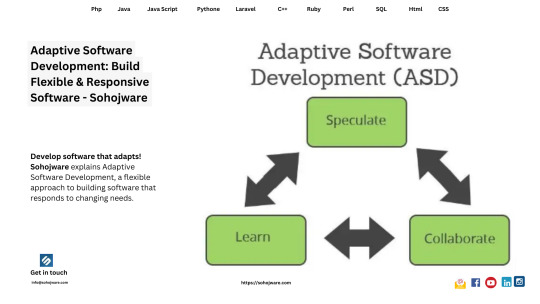
The software landscape is a churning sea of innovation and change. Businesses that rely on rigid, monolithic software applications struggle to keep pace with evolving market demands and user expectations. This is where Adaptive Software Development (ASD) steps in, offering a lifeline for businesses seeking to build software that bends with the times.
ASD in Action: Embracing Change is the New Norm
ASD is an iterative and flexible software development methodology that prioritizes continuous learning and adaptation. Imagine a sculptor meticulously shaping clay, constantly refining their creation based on their vision and the feedback they receive. This is the essence of ASD. Requirements are not set in stone; instead, they are treated as fluid guidelines that can evolve as the project progresses and new information emerges. This adaptability ensures your software remains relevant and competitive in a dynamic marketplace.
Why Choose Adaptive Software Development?
Here's why businesses across the United States are embracing the power of ASD:
Unmatched Agility and Responsiveness: ASD empowers you to respond swiftly to market shifts and customer feedback. New features and functionalities can be readily incorporated through continuous iteration, ensuring your software stays ahead of the curve.
Reduced Risk, Enhanced Confidence: Traditional development methodologies often lead to costly surprises down the road. ASD mitigates this risk by prioritizing early and frequent feedback loops. Potential issues are identified and addressed early in the development cycle, fostering a sense of confidence and control throughout the project.
Happy Stakeholders, Happy Business: ASD fosters a collaborative environment where stakeholders are actively involved throughout the development process. This ongoing communication ensures the final product aligns with their expectations and addresses their specific needs. Satisfied stakeholders translate to a successful project and a thriving business.
Cost-Effective Development: The iterative nature of ASD allows for course correction throughout the development lifecycle. This reduces the risk of costly rework and ensures resources are allocated efficiently. You get the most out of your development budget.
Built to Last: ASD promotes the creation of modular and well-documented software. This translates to easier maintenance, updates, and future scaling, reducing long-term costs and ensuring your software remains a valuable asset for years to come.
How Does Adaptive Software Development Work?
ASD follows a cyclical process that emphasizes continuous learning, feedback, and adaptation. Here's a breakdown of the core principles that guide this dynamic approach:
Continuous Delivery: Frequent releases of working software functionalities are a hallmark of ASD. This allows for early feedback and identification of potential issues, ensuring your software is constantly evolving and improving.
Embrace Change: ASD acknowledges that requirements are likely to fluctuate throughout the development process. The methodology is designed to accommodate these changes seamlessly, ensuring your software stays relevant and meets the ever-evolving needs of your users.
Collaboration is Key: ASD thrives in a collaborative environment where stakeholders, developers, and testers work together as a cohesive unit. This open communication fosters a deeper understanding of project goals and ensures everyone is on the same page.
Refine the Backlog: The project backlog, a prioritized list of features, is continuously refined based on new information and feedback. This ensures development efforts are focused on the most critical functionalities and user needs.
Short Iterations: ASD breaks down the development process into short, manageable iterations. This allows for faster feedback loops, quicker time to market, and a more controlled development process.
Building Software for the Future with Sohojware
Sohojware, a leading software development company with a proven track record of success, is your trusted partner in the world of ASD. Here's why choosing Sohojware for your Adaptive Software Development project is the smart move:
A Team of Seasoned Professionals: Sohojware boasts a team of highly skilled and experienced developers who are well-versed in ASD methodologies. Their expertise ensures your project is navigated smoothly and efficiently.
The Agile Advantage: Sohojware's agile development approach aligns perfectly with the core principles of ASD, ensuring a flexible and responsive development process that adapts to your changing needs.
A History of Success: Sohojware has a well-deserved reputation for delivering successful ASD projects for clients across various industries. Their proven track record gives you peace of mind knowing your project is in capable hands.
Cost-Effective Solutions: Sohojware understands the importance of budget optimization. They offer competitive rates and work closely with clients to develop cost-effective solutions that meet their specific needs.
Your Satisfaction is Our Priority: Sohojware is committed to exceeding client expectations and delivering software that meets their specific needs. Their focus on clear communication and collaboration ensures a successful and rewarding development experience.
Is Adaptive Software Development Right for You?
ASD is a powerful approach for businesses that operate in dynamic and fast-changing markets. Here are some key indicators that ASD might be the perfect fit for your next project:
Market Agility is Paramount: If your industry is subject to rapid shifts and fluctuations, ASD's adaptability allows you to respond quickly and effectively to changing market demands.
Flexibility is Key: ASD embraces change and thrives in environments where requirements are not set in stone. If you anticipate your project needs evolving throughout the development process, ASD can accommodate those changes seamlessly.
Early Feedback is Invaluable: ASD prioritizes early and frequent feedback, allowing you to course-correct and refine your software based on real-time user insights. This is ideal for businesses that value an iterative approach and continuous improvement.
Risk Mitigation is a Priority: Traditional development methodologies can be fraught with unforeseen challenges. ASD's focus on early issue identification and proactive problem-solving minimizes development risks and ensures a smoother project journey.
Building for the Long Haul: ASD promotes the creation of well-documented and modular software. This translates to easier maintenance and future scaling, ensuring your software remains a valuable asset for years to come.
Sohojware Can Help You Navigate the World of ASD
If you're considering Adaptive Software Development for your next project, Sohojware is here to guide you every step of the way. Contact us today for a free consultation! Our experienced team will assess your specific needs and help you determine if ASD is the right approach for you. We can also provide you with a custom quote tailored to your project requirements.
In Conclusion
The business landscape is constantly evolving, and the software you use needs to evolve with it. Adaptive Software Development offers a compelling solution for businesses seeking to build software that is flexible, responsive, and adaptable to change. With its focus on continuous learning and collaboration, ASD empowers you to stay ahead of the curve and deliver exceptional value to your customers.
Sohojware is your trusted partner in the world of ASD. Our team of experts, combined with our agile development approach and commitment to client satisfaction, ensures a successful and rewarding development experience. Let's work together to build software that thrives in the face of change and propels your business forward.
FAQ’s
What are the key differences between Adaptive Software Development and traditional methodologies?
Traditional methodologies often follow a linear development process, where requirements are defined upfront and changes are discouraged. ASD, on the other hand, is an iterative and flexible approach that embraces change and prioritizes continuous learning.
How can Sohojware help me implement Adaptive Software Development?
Sohojware's experienced team will guide you through the entire ASD process, from initial planning and requirement gathering to development, testing, and deployment. We will work closely with you to ensure your project is successful and meets your specific needs.
What are the benefits of working with Sohojware for my Adaptive Software Development project?
Sohojware offers a combination of experience, expertise, and a commitment to client satisfaction. Our agile approach and focus on continuous communication ensure that your project stays on track and delivers the results you expect.
How much does Adaptive Software Development cost?
The cost of Adaptive Software Development can vary depending on the size and complexity of your project. However, Sohojware offers competitive rates and works closely with clients to develop a cost-effective solution that meets their budget.
What are the next steps to get started with Adaptive Software Development at Sohojware?
Contact Sohojware today for a free consultation! Our team will discuss your project requirements and help you determine if Adaptive Software Development is the right approach for you. We can also provide you with a custom quote based on your specific needs.
1 note
·
View note
Text
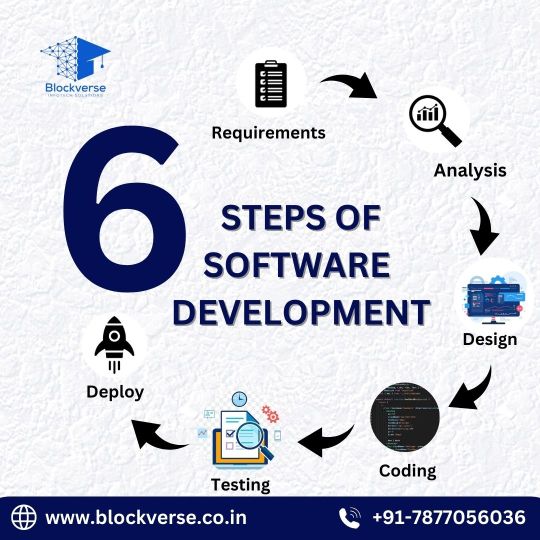
Unraveling the Essentials of Software Development
In today’s digital era, software development stands as the backbone of technological advancement. From powering intricate systems to simplifying everyday tasks, the significance of software in modern life cannot be overstated. Whether you’re an aspiring developer or a business owner venturing into the digital realm, understanding the fundamentals of software development is paramount.
Software development encompasses a myriad of processes, methodologies, and tools aimed at creating functional and user-friendly applications. From conceptualization to deployment, each phase demands meticulous planning, coding prowess, and rigorous testing. Here are some key aspects to delve into:
Planning and Analysis: Every successful software project commences with thorough planning and analysis. This phase involves identifying requirements, understanding user needs, and outlining the project scope.
Design and Architecture: Crafting a robust architecture lays the foundation for a scalable and efficient software solution. Design principles such as modularity, scalability, and maintainability are pivotal in this stage.
Development and Coding: Armed with a solid plan and design, developers embark on coding, breathing life into the software. Proficiency in programming languages, frameworks, and development methodologies is indispensable here.
Testing and Quality Assurance: Rigorous testing ensures that the software meets predefined standards of functionality, performance, and security. Various testing techniques like unit testing, integration testing, and user acceptance testing are employed to identify and rectify defects.
Deployment and Maintenance: Once the software clears the testing phase, it’s ready for deployment. Continuous monitoring, updates, and bug fixes ensure smooth operation and longevity of the software.
In today’s fast-paced digital landscape, Agile methodologies have revolutionized the software development process. Agile emphasizes adaptive planning, iterative development, and close collaboration between cross-functional teams. By embracing Agile principles, organizations can respond swiftly to changing requirements, mitigate risks, and deliver high-quality software in a timely manner.
Software development is a dynamic and multifaceted domain that continues to evolve with technological advancements. By understanding its intricacies and embracing best practices, businesses can leverage software to streamline operations, enhance user experiences, and stay ahead of the competition.
For unrivaled software development solutions tailored to your unique needs, look no further than Blockverse Infotech Solutions. With a team of seasoned developers and a proven track record of delivering cutting-edge software solutions, Blockverse Infotech stands ready to transform your ideas into reality. Whether you’re envisioning a bespoke mobile app, a scalable web platform, or enterprise-grade software, trust Blockverse Infotech to exceed your expectations.
Blockverse Infotech Solutions — Your Partner in Software Development Excellence.
#ibms software#software engineer#adaptive software development#sdlc software#app development software#react native software#ruby on rails software#software agile development#mobile applications development#computer software development
0 notes
Text
Adaptive Software Development (ASD) thrives on embracing change as a core principle, enabling teams to respond dynamically to evolving requirements. By fostering flexibility and collaboration, ASD empowers organizations to stay ahead in a rapidly changing environment, delivering value to customers faster and more effectively. Check complete guide on this.
0 notes
Text
Software Engineer Explores: Software Design Patterns for Enhancing Maintainability and Scalability
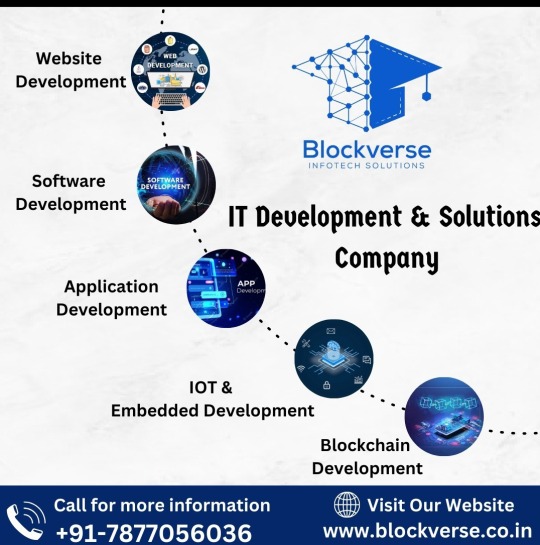
In the fast-paced world of software engineering, crafting robust, maintainable, and scalable solutions is paramount. At Blockverse Infotech Solutions, our team of software engineers is constantly striving to push the boundaries of innovation while ensuring that our products remain reliable and adaptable. One of the key strategies we employ to achieve this is the utilization of software design patterns. In this article, we will delve into the importance of software design patterns in enhancing the maintainability and scalability of software systems, exploring how they enable us to tackle the evolving challenges of modern software development.
Software design patterns are recurring solutions to common problems encountered in software design. They provide a structured approach to solving design issues and promote code reusability, flexibility, and maintainability. By following established design patterns, developers can leverage proven solutions to address specific concerns within their software architecture.
Maintainability refers to the ease with which a software system can be modified, updated, or repaired over time. Software design patterns play a crucial role in enhancing maintainability by promoting modularization and separation of concerns. For example, the Model-View-Controller (MVC) pattern facilitates the separation of user interface logic, business logic, and data manipulation, making it easier to modify one component without affecting others.
Scalability is the ability of a system to handle increasing workload or growth without compromising performance. Design patterns contribute to scalability by enabling developers to design systems that can efficiently adapt to changing requirements and accommodate increased demand. For instance, the Singleton pattern ensures that only one instance of a class exists throughout the application, making it easier to manage shared resources and scale the system horizontally.
Several design patterns are commonly used in software development to address various design challenges. Some of the most widely recognized patterns include:
Factory Method Pattern: Facilitates the creation of objects without specifying the exact class of the object to be created.
Observer Pattern: Defines a one-to-many dependency between objects, ensuring that changes to one object trigger updates in its dependents.
Decorator Pattern: Allows behavior to be added to individual objects dynamically, providing a flexible alternative to subclassing.
In conclusion, software design patterns are invaluable tools for enhancing the maintainability and scalability of software systems. By adopting proven solutions to common design challenges, developers can create software that is more adaptable, resilient, and easier to maintain over time. At Blockverse Infotech Solutions, we recognize the importance of incorporating design patterns into our development practices, enabling us to deliver high-quality solutions that meet the evolving needs of our clients and stakeholders.
#software engineer#adaptive software development#react native software#computer software development#google software engineer#software development services#software development companies near me#software company in jaipur#web software development#it software development company#android app development agency#making an app for android#custom software development companies#ai software development#flutter software
0 notes
Text
Rasping
I maintain and publish a couple open-source libraries that are cross-compiled for 32-bit Linux-on-ARM platforms such as the Raspberry Pi. I think it's important to test the code I publish. Unfortunately, my test machine (a Pi 400) can't execute those binaries because its operating system is too old: in particular, its "stdc++" library isn't recent enough.
A colleague in Cairo, Egypt told me various ways to upgrade the library by installing a newer compiler on the Pi. I tried them last night without success.
My current plan is to install a newer version of the operating system. This involves downloading a disk image and writing it to the Pi's MicroSD card. To do that, I need a USB-MicroSD adapter for my HP laptop. They cost about $10 or $20 online, but I'd rather not wait for shipping. So I'm running out to Staples this morning to buy an adapter.
#open source#software development#raspberry pi#libraries#software testing#linux#cairo#compiler#microsd#old software#errands#operating systems#upgrade#cplusplus#adapter#hp laptop
1 note
·
View note
Text
Upgraded my desk a little bit :)

By upgraded I mean
- A light bar for behind my screen
Honestly I think it just looks cool and I prefer working in ambient lighting
- A new keyboard & mouse (Logi Pop Icon Keys)
I probably didn’t need a new keyboard or mouse but the addition of the action buttons are definitely going to help with workflow and I can use my other on weekends or off days
- A new double sided mouse mat
My old one was starting to peel and fall apart
I think I could do with a better quality, borderless screen at some point but apart from that I’m pretty happy with my desk/setup tbh
Wallpaper - Be Nice & Do Code
Desktop lights - Festivitas
#be nice & do code#I hate that the keyboard is squiffy but that’s how I type lol#also yes that is a Minion tin from McDonald’s I keep my Apple Pencil tips and charging adapter in it#coding#front end developer#software developer#desk setup#codeblr
1 note
·
View note
Text
Maxtra Technologies | Artificial Intelligence Software Development Company
Maxtra Technologies, a trusted Artificial Intelligence Development Company, delivers innovative AI solutions to enhance efficiency, drive growth, and personalize experiences. Unlock AI's full potential with our tailored services, designed to empower businesses and stay ahead in today's competitive market.
Visit Us:
#AI/ML Software Development#Machine Learning App Development Company#AI/ML Development Company#Artificial Intelligence Development Company#Artificial Intelligence Solutions Development Company#Generative AI Development Company#AI Consulting Services#AI Chatbot Development Company#Adaptive AI Development Company#AI Chatbot Development Services
0 notes
Text
https://www.xcrino.com/gym-management-software-in-delhi-ncr-india
Smart Gym Management Documentation by Xcrino
Smart Gym Management Documentation by Xcrino is a comprehensive guide that provides detailed information on how to effectively manage a gym or fitness center using the Xcrino gym management software. This documentation covers various aspects of gym management, including member management, sales and marketing, financial management, and facility management.
#Software#sales and marketing#financial management#facility management#staff training and development#group fitness and personal training#data and analytics#customer relationship management#social media and online presence#strategic partnerships and collaborations#branding and messaging#technology and innovation#adaptability and resilience
0 notes
Text
Why Adaptive Software Development is the Future of Agile
Discover why Adaptive Software Development (ASD) is redefining Agile with flexibility, collaboration, and continuous improvement for complex projects.
Agile methodologies have become the cornerstone of modern software development, offering a framework that prioritizes flexibility, rapid delivery, and close collaboration between developers and stakeholders. Among the agile frameworks, Adaptive Software Development (ASD) has emerged as a robust approach designed to handle the complexities of evolving projects, making it increasingly popular in…
#Adaptive Software Development#agile#Agile Framework#Agile Methodology#ASD#autism#Future Of Agile#mental-health#Project Management#Rapid Application Development#Software Development#Tech Innovation
0 notes
Text
The conversation around AI is going to get away from us quickly because people lack the language to distinguish types of AI--and it's not their fault. Companies love to slap "AI" on anything they believe can pass for something "intelligent" a computer program is doing. And this muddies the waters when people want to talk about AI when the exact same word covers a wide umbrella and they themselves don't know how to qualify the distinctions within.
I'm a software engineer and not a data scientist, so I'm not exactly at the level of domain expert. But I work with data scientists, and I have at least rudimentary college-level knowledge of machine learning and linear algebra from my CS degree. So I want to give some quick guidance.
What is AI? And what is not AI?
So what's the difference between just a computer program, and an "AI" program? Computers can do a lot of smart things, and companies love the idea of calling anything that seems smart enough "AI", but industry-wise the question of "how smart" a program is has nothing to do with whether it is AI.
A regular, non-AI computer program is procedural, and rigidly defined. I could "program" traffic light behavior that essentially goes { if(light === green) { go(); } else { stop();} }. I've told it in simple and rigid terms what condition to check, and how to behave based on that check. (A better program would have a lot more to check for, like signs and road conditions and pedestrians in the street, and those things will still need to be spelled out.)
An AI traffic light behavior is generated by machine-learning, which simplistically is a huge cranking machine of linear algebra which you feed training data into and it "learns" from. By "learning" I mean it's developing a complex and opaque model of parameters to fit the training data (but not over-fit). In this case the training data probably includes thousands of videos of car behavior at traffic intersections. Through parameter tweaking and model adjustment, data scientists will turn this crank over and over adjusting it to create something which, in very opaque terms, has developed a model that will guess the right behavioral output for any future scenario.
A well-trained model would be fed a green light and know to go, and a red light and know to stop, and 'green but there's a kid in the road' and know to stop. A very very well-trained model can probably do this better than my program above, because it has the capacity to be more adaptive than my rigidly-defined thing if the rigidly-defined program is missing some considerations. But if the AI model makes a wrong choice, it is significantly harder to trace down why exactly it did that.
Because again, the reason it's making this decision may be very opaque. It's like engineering a very specific plinko machine which gets tweaked to be very good at taking a road input and giving the right output. But like if that plinko machine contained millions of pegs and none of them necessarily correlated to anything to do with the road. There's possibly no "if green, go, else stop" to look for. (Maybe there is, for traffic light specifically as that is intentionally very simplistic. But a model trained to recognize written numbers for example likely contains no parameters at all that you could map to ideas a human has like "look for a rigid line in the number". The parameters may be all, to humans, meaningless.)
So, that's basics. Here are some categories of things which get called AI:
"AI" which is just genuinely not AI
There's plenty of software that follows a normal, procedural program defined rigidly, with no linear algebra model training, that companies would love to brand as "AI" because it sounds cool.
Something like motion detection/tracking might be sold as artificially intelligent. But under the covers that can be done as simply as "if some range of pixels changes color by a certain amount, flag as motion"
2. AI which IS genuinely AI, but is not the kind of AI everyone is talking about right now
"AI", by which I mean machine learning using linear algebra, is very good at being fed a lot of training data, and then coming up with an ability to go and categorize real information.
The AI technology that looks at cells and determines whether they're cancer or not, that is using this technology. OCR (Optical Character Recognition) is the technology that can take an image of hand-written text and transcribe it. Again, it's using linear algebra, so yes it's AI.
Many other such examples exist, and have been around for quite a good number of years. They share the genre of technology, which is machine learning models, but these are not the Large Language Model Generative AI that is all over the media. Criticizing these would be like criticizing airplanes when you're actually mad at military drones. It's the same "makes fly in the air" technology but their impact is very different.
3. The AI we ARE talking about. "Chat-gpt" type of Generative AI which uses LLMs ("Large Language Models")
If there was one word I wish people would know in all this, it's LLM (Large Language Model). This describes the KIND of machine learning model that Chat-GPT/midjourney/stablediffusion are fueled by. They're so extremely powerfully trained on human language that they can take an input of conversational language and create a predictive output that is human coherent. (I am less certain what additional technology fuels art-creation, specifically, but considering the AI art generation has risen hand-in-hand with the advent of powerful LLM, I'm at least confident in saying it is still corely LLM).
This technology isn't exactly brand new (predictive text has been using it, but more like the mostly innocent and much less successful older sibling of some celebrity, who no one really thinks about.) But the scale and power of LLM-based AI technology is what is new with Chat-GPT.
This is the generative AI, and even better, the large language model generative AI.
(Data scientists, feel free to add on or correct anything.)
3K notes
·
View notes
Text
★ Embrace Uncertainty for True Happiness

I recently started reading this amazing book about Emotional Intelligence and it totally opened my eyes to how important it is in our daily lives. Emotional Intelligence isn’t just about understanding our feelings—it’s also about being flexible and open to whatever life throws our way.
Just imagine this: You’ve set your heart on landing a specific job right after university. You imagine how perfect it will be working there, you already know how you'll organise your desk, and window shopping your future office outfits. But when things don’t go as planned i.e. you don't get the job, you feel crushed and start doubting yourself and feel you're not good enough or just plain unlucky in life. Personally I've been there TOO many times. This fixed mindset can blind you to other awesome opportunities that might be just as fulfilling.
However, I have some tips from the book on how to emotionally manage these kinds of situations!

▸ Step 1: Stay Open-Minded
Tell yourself, “I don’t know what the future holds, but I’m open to learning and growing from whatever comes my way.” Let go of those rigid expectations and embrace life’s unpredictability.
Why it matters: Staying open-minded helps you adapt to new situations and discover unexpected joys.
Real Talk: I once had a super fixed idea of becoming a neurosurgeon (brain doctor), but when I left highschool early, I thought I would be a failure forever. Then a Software Development apprenticeship opportunity popped up, I decided to give it a shot. It turned out to be one of the best decisions I ever made!
▸ Step 2: Focus on the Present
Make the most of your current experiences instead of always planning for some future “perfect” situation. Ask yourself, “What’s good about this moment right now?”
How to do it: Try practicing mindfulness through meditation or just take a few minutes each day to appreciate your surroundings.
Pro Tip: Start a gratitude journal. Every day, jot down three things you’re thankful for in the present moment. It’s a game-changer!
▸ Step 3: Embrace Growth in All Experiences
When challenges come your way, look for opportunities to learn or grow. Instead of labelling something as entirely good or bad, ask, “What can I take from this experience to make me stronger or wiser?”
Action step: After any setback, take a moment to reflect on what you’ve learned and how you can use it moving forward.
Personal Insight: During a tough breakup, instead of dwelling on the pain, I focused on what the relationship taught me about my needs and boundaries. This helped me grow and prepare for healthier relationships in the future.

Building emotional intelligence isn’t something you do overnight—it’s a continuous journey of self-discovery and adaptation.
So, as you navigate your own path, remember to embrace the uncertainty and trust that each experience, whether good or bad, is shaping you into a stronger, wiser version of yourself.
Here’s to your amazing journey ahead,

#emotional intelligence#it girl#it girl energy#growth#self growth#self improvement#self development#self love#becoming that girl#girlboss#girlblog#girlblogging#advice#book rec#self esteem#studyblr#tumblr girls#girlhood#womanhood
519 notes
·
View notes
Text
TVs and monitors are separate species with common features, but which features these are have drastically changed over time. the two used to be similar sizes with very similar behaviour, and were differentiated primarily by which connection ports they had.
over time, their courses of evolution brought them closer together in that regard, with both species' survival becoming contingent on how well they could digest HDMI. as their analogue prey, such as VGA and Component, died out, the two display species were faced with the same choice: adapt, or die.
despite this newfound similarity, though, the two species still fill different ecological niches, and the way they adapted to these new environmental situations resulted in further physical distinction in other areas. for example, it is now almost impossible to find a modern TV that is a comparable size to a monitor; while the modern monitor is still limited in dimensions by the desktops where it prefers to nest, the modern TV has an almost unbounded adult size.
another strange new differentiation is that the TV seems to have developed a dependence on internet connectivity and software updates. while this benefits them in the short term, having more selling points than a monitor at first glance, it is working against them in the long-term, with each one's effective lifespan being cut dramatically.
the "dumb TV" that, quite intelligently, does not have any big software features, is nearing extinction, with very few members still producing offspring. and while we may feel sorrow for these displays, it is only natural that they are dying off - they are simply being outcompeted by the once-humble monitor. at the same size, and without the advantage of a wider variety of ports, the dumb TV cannot keep up with the monitor's much more refined adaptations for the same niche.
however, one mystery remains: why did the dumb TV never grow to the same impressive dimensions as its smart siblings? some observations suggests that the larger smart TVs have become overly territorial as a result of their decreased longevity, to the point that they will kill an infant dumb TV if they feel that it could grow to compete with them. it seems cruel to us, but in the wild, it's all a matter of survival. if you win the evolutionary race - you fight to keep first place.
#this is a long way of saying “if you want a small dumb TV and don't need analogue connections you can just buy a monitor of the same size”#finding a good modern dumb TV? nigh-impossible. finding a good monitor? pretty easy actually! dunno how i didn't realise this sooner.
1K notes
·
View notes
Text
Great Big Good Omens Graphic Novel Update
AKA A Visit From Bildad the Shuhite.
The past year or so has been one long visit from this guy, whereupon he smiteth my goats and burneth my crops, woe unto the woeful cartoonist.
Gaze upon the horror of Bildad the Shuhite.

You kind of have to be a Good Omens fan to get this joke, but trust me, it's hilarious.
Anyway, as a long time Good Omens novel fan, you may imagine how thrilled I was to get picked to adapt the graphic novel.
Go me!

This is quite a task, I have to say, especially since I was originally going to just draw (and color) it, but I ended up writing the adaptation as well. Tricky to fit a 400 page novel into a 160-ish page graphic novel, especially when so much of the humor is dependent on the language, and not necessarily on the visuals.
Not complainin', just sayin'.
Anyway, I started out the gate like a herd of turtles, because right away I got COVID which knocked me on my butt.
And COVID brain fog? That's a thing. I already struggle with brain fog due to autoimmune disease, and COVID made it worse.
Not complainin' just sayin'.
This set a few of the assignments on my plate back, which pushed starting Good Omens back.
But hey, big fat lead time! No worries!
Then my computer crawled toward the grave.
My trusty MAC Pro Tower was nearly 15 years old when its sturdy heart ground to a near-halt with daily crashes. I finally got around to doing some diagnostics; some of its little brain actions were at 5% functionality. I had no reliable backups.
There are so many issues with getting a new computer when you haven't had a new computer or peripherals in nearly fifteen years and all of your software, including your Photoshop program is fifteen years old.
At the time, I was still on rural internet...which means dial-up speed.

Whatever you have for internet in the city, roll that clock back to about 2001.
That's what I had. I not only had to replace almost all of my hardware but I had to load and update all programs at dial-up speed.
Welcome to my gigabyte hell.
The entire process of replacing the equipment and programs took weeks and then I had to relearn all the software.
All of this was super expensive in terms of money and time cost.
But I was not daunted! Nosirree!
I still had a huge lead time! I can do anything! I have an iron will!
And boy, howdy, I was going to need it.
At about the same time, a big fatcat quadrillionaire client who had hired me years ago to develop a big, major transmedia project for which I was paid almost entirely in stock, went bankrupt leaving everyone holding the bag, and taking a huge chunk of my future retirement fund with it.
I wrote a very snarky almost hilarious Patreon post about it, but am not entirely in a position to speak freely because I don't want to get sued. Even though I had to go to court over it, (and I had to do that over Zoom at dial-up speed,) I'm pretty sure I'll never get anything out of this drama, and neither will anyone else involved, except millionaire dude and his buddies who all walked away with huge multi-million dollar bonuses weeks before they declared bankruptcy, all the while claiming they would not declare bankruptcy.
Even the accountant got $250,000 a month to shut down the business, while creators got nothing.
That in itself was enough drama for the year, but we were only at February by that point, and with all those months left, 2023 had a lot more to throw at me.
Fresh from my return from my Society of Illustrators show, and a lovely time at MOCCA, it was time to face practical medical issues, health updates, screening, and the like. I did my adult duty and then went back to work hoping for no news, but still had a weird feeling there would be news.

I know everyone says that, but I mean it. I had a bad feeling.
Then there was news.
I was called back for tests and more tests. This took weeks. The ubiquitous biopsy looked, even to me staring at the screen in real time, like bad news.
It also hurt like a mofo after the anesthesia wore off. I wasn't expecting that.
Then I got the official bad news.
Cancer which runs in my family finally got me. Frankly, I was surprised I didn't get it sooner.
Stage 0, and treatment would likely be fast and complication-free. Face the peril, get it over with, and get back to work.
I requested surgery months in the future so I could finish Good Omens first, but my doc convinced me the risk of waiting was too great. Get it done now.
"You're really healthy," my doc said. Despite an auto-immune issue which plagues me, I am way healthier than the average schmoe of late middle age. She informed me I would not even need any chemo or radiation if I took care of this now.

So I canceled my appearance at San Diego Comic Con. I did not inform the Good Omens team of my issues right away, thinking this would not interfere with my work schedule, but I did contact my agent to inform her of the issue. I also contacted a lawyer to rewrite my will and make sure the team had access to my digital files in case there were complications.
Then I got back to work, and hoped for the best.
Eff this guy.

Before I could even plant my carcass on the surgery table, I got a massive case of ocular shingles.
I didn't even know there was such a thing.
There I was, minding my own business. I go to bed one night with a scratchy eye, and by 4 PM the next day, I was in the emergency room being told if I didn't get immediate specialist treatment, I was in big trouble.
I got transferred to another hospital and got all the scary details, with the extra horrid news that I could not possibly have cancer surgery until I was free of shingles, and if I did not follow a rather brutal treatment procedure - which meant super-painful eye drops every half hour, twenty-four hours a day and daily hospital treatment - I could lose the eye entirely, or be blinded, or best case scenario, get permanent eye damage.
What was even funnier (yeah, hilarity) is the drops are so toxic if you don't use the medication just right, you can go blind anyway.
Hi Ho.
Ulcer is on the right. That big green blob.
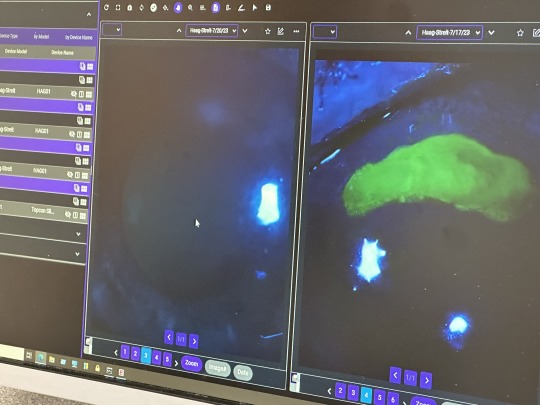
I had just finished telling my cancer surgeon I did not even really care about getting cancer, was happy it was just stage zero, had no issues with scarring, wanted no reconstruction, all I cared about was my work.
Just cut it out and get me back to work.
And now I wondered if I was going to lose my ability to work anyway.
Shingles often accompanies cancer because of the stress on the immune system, and yeah, it's not pretty. This is me looking like all heck after I started to get better.

The first couple of weeks were pretty demoralizing as I expected a straight trajectory to wellness. But it was up and down all the way.
Some days I could not see out of either eye at all. The swelling was so bad that I had to reach around to my good eye to prop the lid open. Light sensitivity made seeing out of either eye almost impossible. Outdoors, even with sunglasses, I had to be led around by the hand.
I had an amazing doctor. I meticulously followed his instructions, and I think he was surprised I did. The treatment is really difficult, and if you don't do it just right no matter how painful it gets, you will be sorry.
To my amazement, after about a month, my doctor informed me I had no vision loss in the eye at all. "This never happens," he said.
I'd spent a couple of weeks there trying to learn to draw in the near-dark with one eye, and in the end, I got all my sight back.
I could no longer wear contact lenses (I don't really wear them anyway, unless I'm going to the movies,) would need hard core sun protection for awhile, and the neuralgia and sun sensitivity were likely to linger. But I could get back to work.
I have never been more grateful in my life.
Neuralgia sucks, by the way, I'm still dealing with it months later.
Anyway, I decided to finally go ahead and tell the Good Omens team what was going on, especially since this was all happening around the time the Kickstarter was gearing up.
Now that I was sure I'd passed the eye peril, and my surgery for Stage 0 was going to be no big deal, I figured all was a go. I was still pretty uncomfortable and weak, and my ideal deadline was blown, but with the book not coming out for more than a year, all would be OK. I quit a bunch of jobs I had lined up to start after Good Omens, since the project was going to run far longer than I'd planned.
Everybody on the team was super-nice, and I was pretty optimistic at this time. But work was going pretty slow during, as you may imagine.
But again...lots of lead time still left, go me.
Then I finally got my surgery.
Which was not as happy an experience as I had been hoping for.
My family said the doc came out of the operating room looking like she'd been pulled backwards through a pipe, She informed them the tumor which looked tiny on the scan was "...huge and her insides are a mess."
Which was super not fun news.
Eff this guy.

The tumor was hiding behind some dense tissue and cysts. After more tests, it was determined I'd need another surgery and was going to have to get further treatments after all.
The biopsy had been really painful, but the discomfort was gone after about a week, so no biggee. The second surgery was, weirdly, not as painful as the biopsy, but the fatigue was big time.
By then, the Good Omens Kickstarter had about run its course, and the record-breaker was both gratifying and a source of immense social pressure.
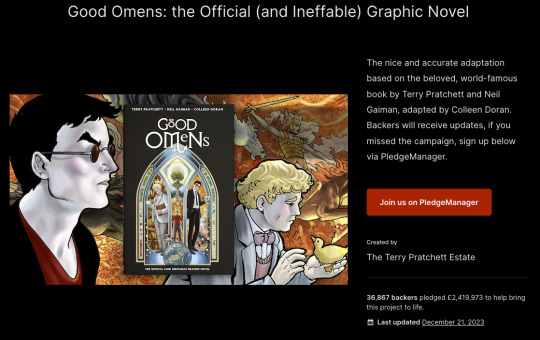
I'd already turned most of my social media over to an assistant, and I'm glad I did.
But the next surgery was what really kicked me on my keister.
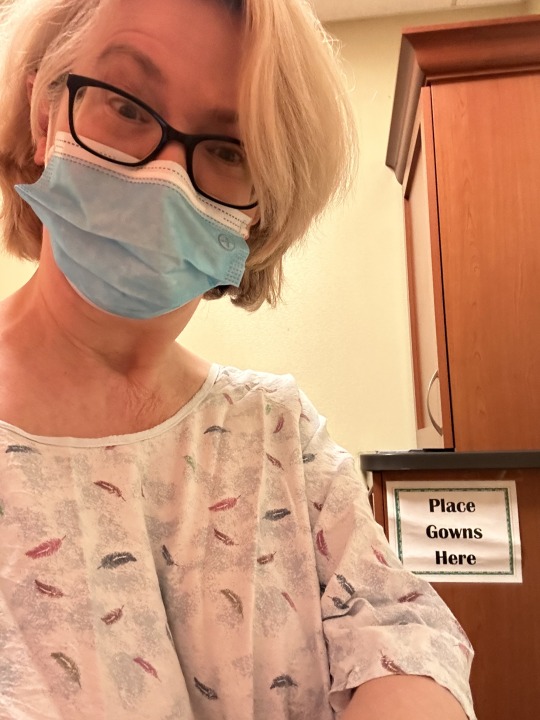
All in all, they took out an area the size of a baseball. It was hard to move and wiped me out for weeks and weeks. I could not take care of myself. I'd begun losing hair by this time anyway, and finally just lopped it off since it was too heavy for me to care for myself. The cut hides the bald spots pretty well.
After about a month, I got the go-ahead to travel to my show at the San Diego Comic Con Museum (which is running until the first week of April, BTW). I was very happy I had enough energy to do it. But as soon as I got back, I had to return to treatment.
Since I live way out in the country, going into the city to various hospitals and pharmacies was a real challenge. I made more than 100 trips last year, and a drive to the compounding pharmacy which produced the specialist eye medicine I could not get anywhere else was six hours alone.
Naturally, I wasn't getting anything done during this time.
But at least my main hospital is super swank.


The oncology treatment went smoothly, until it didn't. The feels don't hit you until the end. By then I was flattened.
So flattened that I was too weak to control myself, fell over, and smashed my face into some equipment.

Nearly tore off my damn nostril.
Eff this guy.

Anyway, it was a bad year.
Here's what went right.
I have a good health insurance policy. The final tally on my health care costs ended up being about $150,000. I paid about 18% of that, including insurance. I had a high deductible and some experimental medicine insurance didn't cover. I had savings, enough to cover the months I wasn't working, and my Patreon is also very supportive. So you didn't see me running a Gofundme or anything.
Thanks to everyone who ever bought one of my books.
No, none of that money was Good Omens Kickstarter money. I won't get most of my pay on that for months, which is just as well because it kept my taxes lower last year when I needed a break.
So, yay.
My nose is nearly healed. I opted out of plastic surgery, and it just sealed up by itself. I'll never be ready for my closeup, but who the hell cares.
I got to ring the bell.
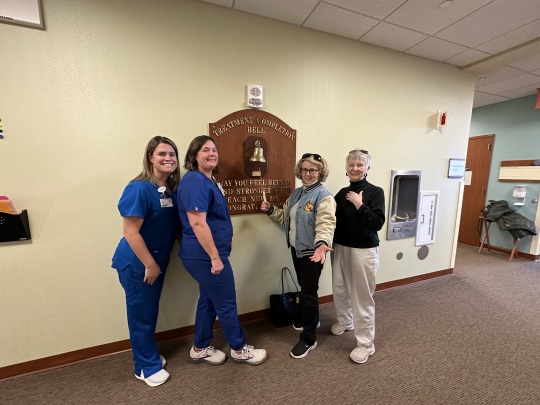
I had a very, VERY hard time getting back to work, especially with regard to focus and concentration. My work hours dropped by over 2/3. I was so fractured and weak, time kept slipping away while I sat in the studio like a zombie. Most of the last six months were a wash.
I assumed focus issues were due (in part) to stress, so sought counseling. This seemed like a good idea at first, but when the counselor asked me to detail my issues with anxiety, I spent two weeks doing just that and getting way more anxious, which was not helpful.
After that I went EFF THIS NOISE, I want practical tools, not touchy feelies (no judgment on people who need touchy-feelies, I need a pragmatic solution and I need it now,) so tried using the body doubling focus group technique for concentration and deep work.
Within two weeks, I returned to normal work hours.
I got rural broadband, jumping me from dial up speed to 1 GB per second.
It's a miracle.

Massive doses of Vitamin D3 and K2. Yay.
The new computer works great.
The Kickstarter did so well, we got to expand the graphic novel to 200 pages. Double yay.
I'm running late, but everyone on the Good Omens team is super supportive. I don't know if I am going to make the book late or not, but if I do, well, it surely wasn't on purpose, and it won't be super late anyway. I still have months of lead time left.
I used to be something of a social media addict, but now I hardly ever even look at it, haven't been directly on some sites in over a year, and no longer miss it. It used to seem important and now doesn't.
More time for real life.
While I think the last year aged me about twenty years, I actually like me better with short hair. I'm keeping it.

OK. Rough year.
Not complainin', just sayin'.
Back to work on The Book.
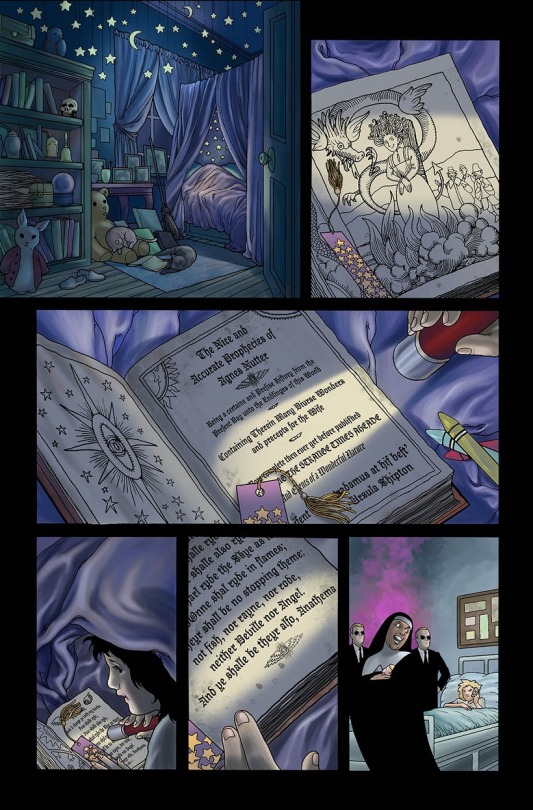
And only a day left to vote for Good Omens, Neil Gaiman, and Sandman in the Comicscene Awards. Thanks.
2K notes
·
View notes
Text
I suggested previously that a Gotek floppy emulator would probably be the easiest way to get this old Sanyo MBC-1000 booted and running again. Turns out that was even easier than I expected.
The first thing I did was reflash the Gotek with FlashFloppy to add support for more image and drive types. FlashFloppy doesn't directly support Teledisk images, but the HxC software can convert them into something both FlashFloppy and HxC can use on a Gotek. I only needed a normal 34-pin ribbon cable for the mainboard interface, and I cobbled together a USB power adapter.
And ... that was it. The computer booted right into CP/M 2.2 without any complaints.

I do still want to try developing some new hardware for this machine. Now that I have a proper operating system with BASIC and an assembler, development should go much smoother.
103 notes
·
View notes